The 2005 Ford F250 had a very impressive towing capacity attached to it, similar to what the F350s were able to achieve, and this was mainly due to the fact that these two trucks shared a lot of the same equipment and options which equated to the data being very similar as well.
These trucks were able to achieve a maximum trailer weight rating of 16,500 pounds, which is quite impressive, but some models were only able to achieve less than half of that, or 8,000 pounds, so you really need to look at the available options that were offered for these trucks in order to see where your vehicle lies.
Your owner's manual contains a lot of information about your truck and I recommend that you read through it and follow all of Ford's recommendations and requirements.
2005 F-250 Overview
Overall Capacity: The Overall towing capacity for the 2005 Ford F250s ranged from 8,000-16,500 lbs., which is a pretty big gap of more than 8,000 pounds difference. Certain variables affected the maximum trailer weight ratings and the two variables that affected these ratings the most were the engine you had equipped and the axle ratio your rear end used.
Capacity By Trim Level Options: I wanted to take the five different trim levels that were available for these trucks and compare the different capacity ranges, according to the engine options there were offered for each trim level. This is what I got...
- XL: 8,000-16,500 lbs.
- XLT: 8,000-16,500 lbs.
- Lariat: 8,000-16,500 lbs.
- King Ranch: 9,000-16,500 lbs.
- Harley Davidson: 12,500-16,500 lbs.
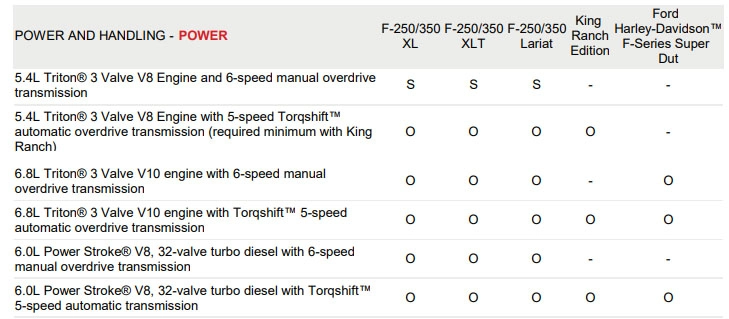
(S) Standard (O) Optional — Not Available
By Engine Options: I also took the three different engine options that were available and decided to see what the capacity ranges were for each engine option, in order to break down the data even further for better comparisons.
- 5.4L: 8,000-12,000 lbs.
- 6.8L: 12,500-16,500 lbs.
- 6.0L: 12,500-16,500 lbs.
Conventional and 5th Wheel Specs: Another way to break down the data was comparing conventional hitch specifications with fifth wheel hitch specifications, and if we look at the data below, we can see that it was quite different between the two types of hitches.
On the low side, both types of hitches had an 8,000 pound minimum capacity rating, but on the high end, there was a 4,000 pound difference between the conventional hitches and fifth wheel hitches.
- Conventional: 8,000-12,500 lbs.
- 5th Wheel: 8,000-16,500 lbs.
The Two Tow Charts:
The F-250 trucks shared their charts with the larger F-350 trucks, so I decided to outline the 250's specs in order to make reading the data easier. The two trucks also shared the same three engine choices, which further complicated the data, but outlining the correct metrics did help to eliminate a lot of the confusion.
Like most of the other Ford vehicles, you will need to know a few things about your truck and plug those variables into the chart in order to get your maximum trailer weight rating. The engine you have equipped and the axle ratio your rear axle is set at are the two main factors that will affect your rating, along with a couple of other more minor variables like automatic vs manual transmission, cab style, 4WD vs 2WD etc.
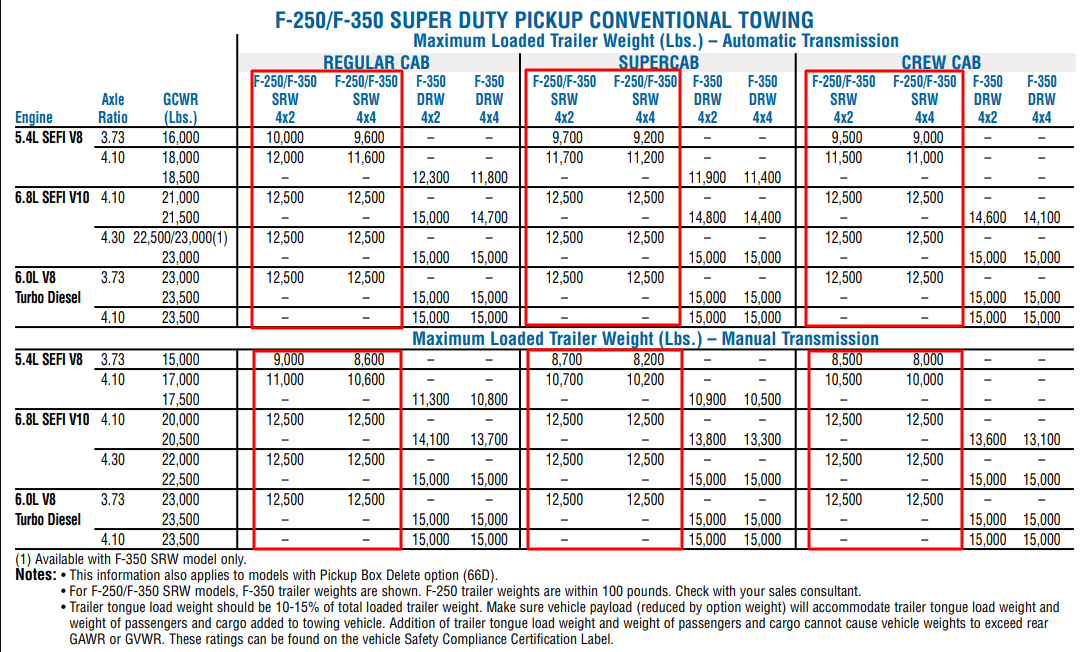
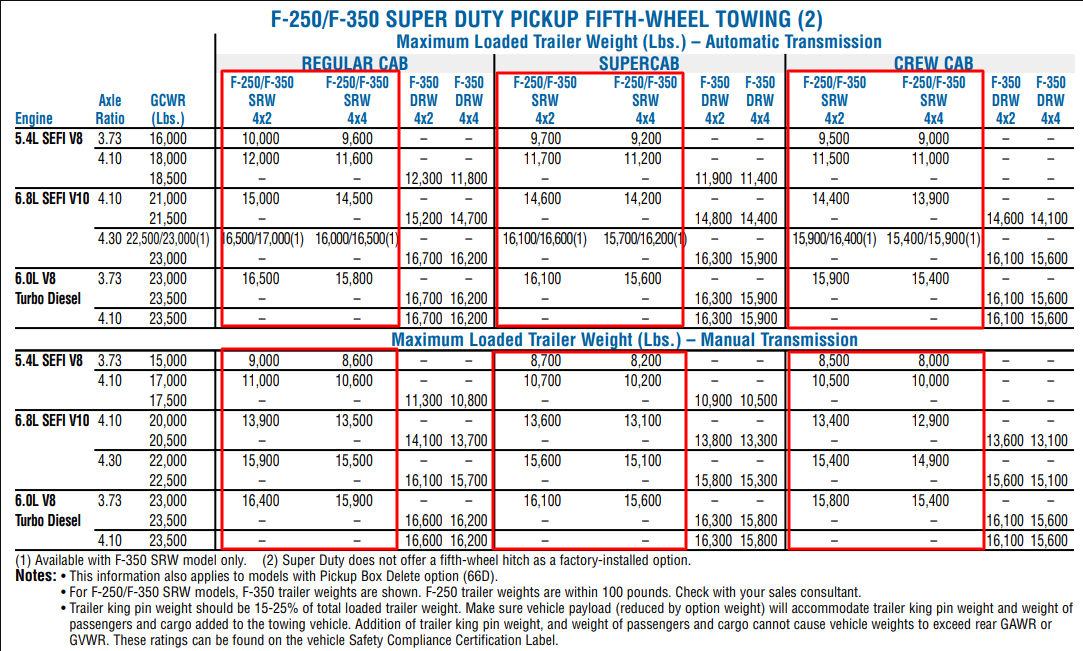

Trailer Tow Package Options:
I was also able to locate a chart that shows us what was included with the trailer towing packages for these trucks, which were standard options, might I add. If we look below at the chart, we can see that the F-250's and 350's shared the same equipment and there wasn't much included, as far as accessories go.
You get a 4/7 pin connector and wiring harness to connect your trailer lights and brakes, and that's about it. The rear stabilization bar was only for DRW models, which was only available for the F350 trucks, so it did not apply to what we were looking at.
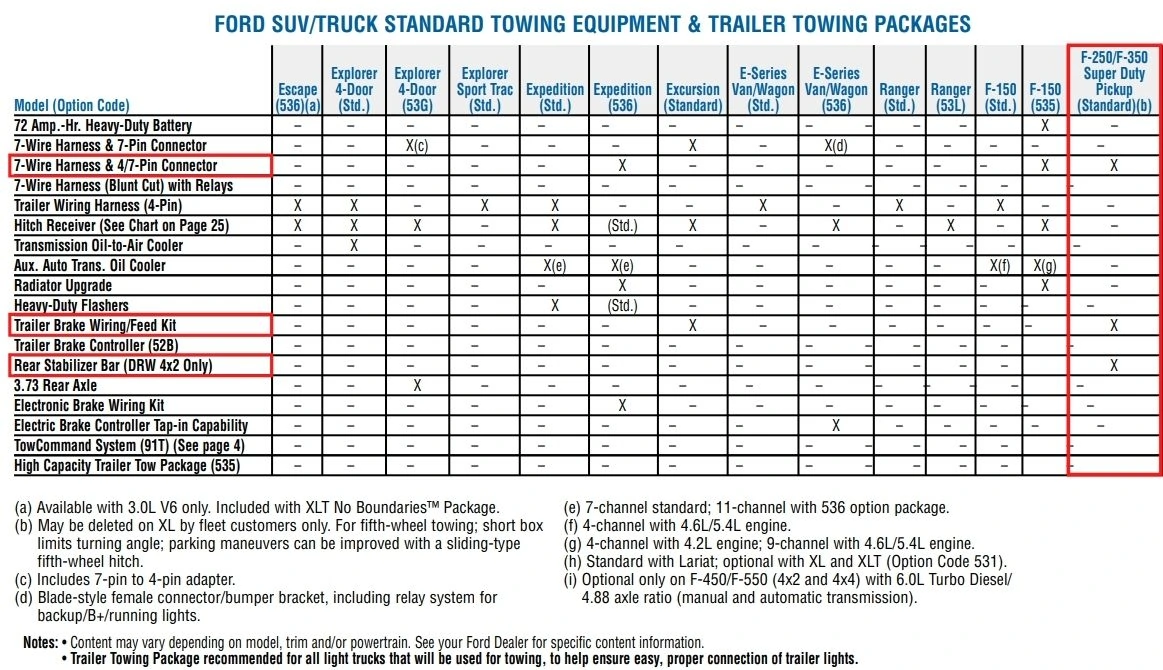
Hitch Reciever Capacities: The hitch receiver capacities were also listed in a table and if we look at the data below, we have maximum weight limits for not only the step bumper hitch, which is at the top of the chart, but also two different ratings for the conventional type of hitch which they divided up into a weight-carrying hitch and then a weight distributing hitch.
If you're using a standard weight carrying hitch, which most people will end up using, then you are limited to a 5,000 lb. capacity, unless you have a weight distributing hitch installed, in which case you would be able to achieve the higher ratings that we saw on the charts.
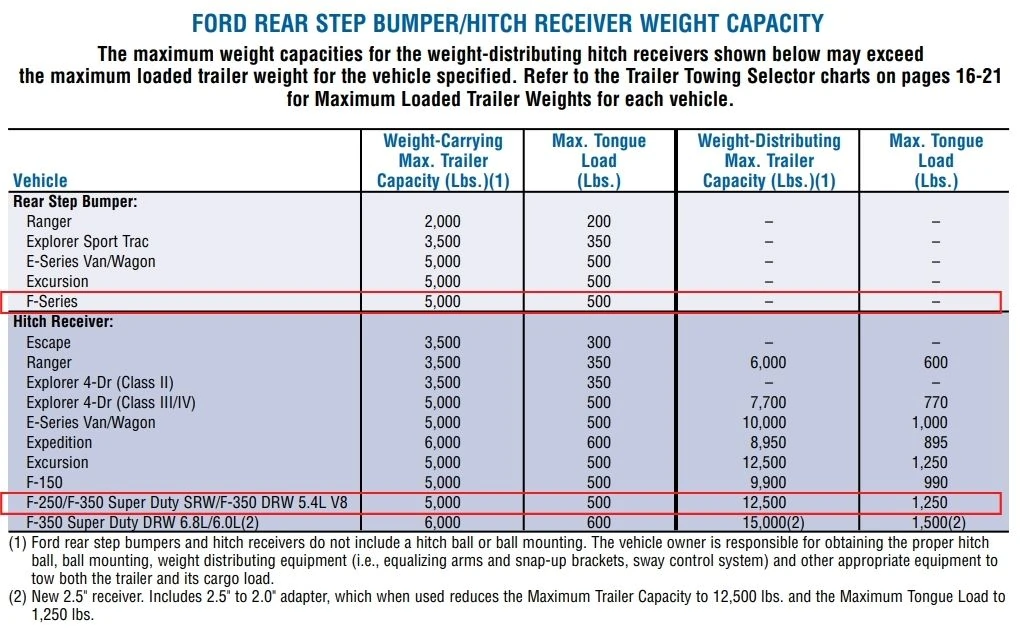
Cab Styles: There were three different cab Styles available for these trucks, like most other Ford trucks and I went ahead and listed the three different options below, so you can line up your cab style on your truck and plug that data into the charts.

Trailer Brakes: Trailer brakes are required in certain States when your trailer weighs over a specific amount of weight and these trucks were able to have trailer brakes installed, but there was not much information about them in the owner's manual other than the small excerpt I found and posted a screenshot of below.
I recommend that you read through this section of your owner's manual a little bit more thoroughly.

The Certification Label...
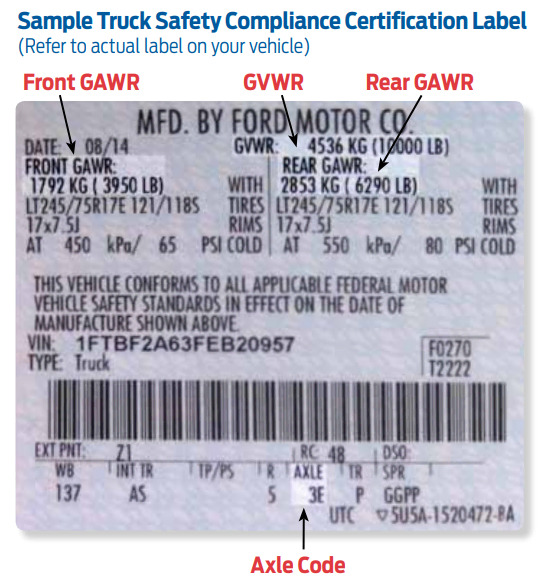
GVWR & GAWRs: The gross combined weight ratings were provided in the chart for us, which made it really easy to find those specifications, but the gross vehicle weight ratings and the gross axle weight ratings were not listed in any of the resources that I used when conducting the research for this article.
You will find these to metrics on the certification label instead, which is located on your driver side door pillar of your truck or sometimes even the door itself, and this label will look like the label that I have pictured above.
The gross vehicle weight rating and both of the gross axle weight ratings will be listed towards the top of this label, which I outline in the sample label that I have posted above.
GCWR: Like I already mentioned, the gross combined weight ratings were listed in the charts and if we look at the data for these trucks, we can see that the gross combined weight ratings ranged from 16,000-23,500 pounds.
Axle Code: I also want to point out that there was a section at the bottom of this label that contained the axle code that was a quick tan your truck from the factory, which will be a two-digit code and I also pointed this out in the above image. This code will tell you what axle ratio was equipped on your rear axle of your truck at the factory, but you will have to decipher this code in order to get that information.
Unfortunately, for did not provide a legend to decipher this code, so you will have to use a third-party website, I like to use this one.
A Few Helpful Links:
I only I needed to use a few different resources to gather the information for this article, three to be exact which I link to below, if you want to check those out in more detail. Each resource provided me specific information about these trucks and when I combine the different information that came from the different resources, I had a comprehensive amount of data that I organized and threw together, forming this article.
The guide was definitely the most helpful resource out of the three, but the owner's manual also came in handy for some of the more specific details.
Last updated on April 27th, 2022 at 06:46 pm
